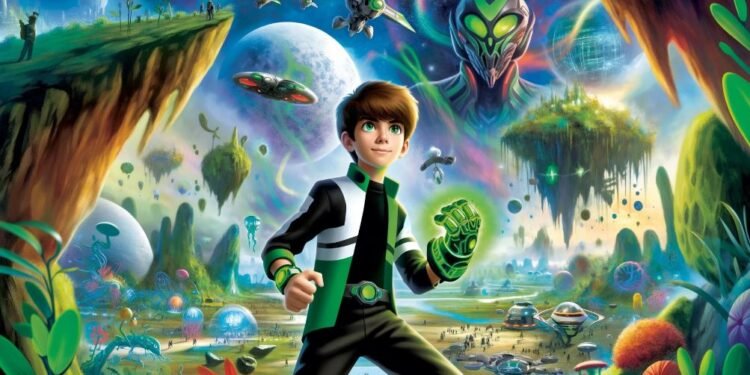Last Updated on November 12, 2023 by admin
Ben 10, a name synonymous with intergalactic heroism, childhood adventure, and a touch of nostalgia, has carved out a unique place in the landscape of animated television. This article delves into the phenomenon of Ben 10, exploring its inception, evolution, and impact on its audience and the animation industry.
Inception and Conceptualization
The story of Ben 10 began in the early 2000s at Cartoon Network Studios. The show was the brainchild of the “Man of Action” team, comprising Duncan Rouleau, Joe Casey, Joe Kelly, and Steven T. Seagle. The concept was simple yet captivating: a young boy named Ben Tennyson discovers an alien device, the Omnitrix, which allows him to transform into various alien species, each with unique powers.
This premise offered an endless canvas for creativity and adventure. From the beginning, Ben 10 was envisioned as a character-driven story, intertwining the excitement of alien transformations with relatable themes such as growing up, responsibility, and the power of family and friendship. These elements were crucial in anchoring the fantastical aspects of the show to a narrative that young viewers could connect with.
Evolution of the Series
Ben 10 debuted in 2005 and was an instant hit. The original series, often called “Ben 10 Classic,” laid the groundwork for a vast and diverse franchise. Over the years, the Ben 10 universe expanded through various iterations: “Ben 10: Alien Force,” “Ben 10: Ultimate Alien,” “Ben 10: Omniverse,” and a 2016 reboot, each targeting different age groups and experimenting with new storylines and character developments.
Ben 10 Classic (2005-2008)
The original series introduced viewers to 10-year-old Ben Tennyson, his cousin Gwen, and their grandfather Max. The interplay of these characters, along with the episodic alien encounters, provided a perfect blend of action, humor, and heart. This series established the core elements of the Ben 10 formula: the Omnitrix, the aliens, and the villains.
Ben 10: Alien Force (2008-2010)
As the audience grew, so did Ben. “Alien Force” portrayed a 15-year-old Ben, dealing with more complex themes and a darker tone. This series introduced new aliens and a deeper look into the Omnitrix’s origin and purpose. Here, the narrative took a more serialized approach, weaving a larger story across episodes.
Ben 10: Ultimate Alien (2010-2012)
Continuing the trend, “Ultimate Alien” explored an older, more mature Ben, now a known hero on Earth. This series introduced the Ultimatrix, an upgraded version of the Omnitrix, allowing Ben to access more potent forms of his alien personas. The storyline became more intricate, with multi-episode arcs and a focus on character development.
Ben 10: Omniverse (2012-2014)
“Omniverse” shifted gears by introducing a dual narrative, alternating between a young Ben from the classic series and a 16-year-old Ben. This approach allowed for a rich exploration of the character’s growth and a return to the original series’s lighter, more adventurous tone.
The 2016 Reboot
The “Ben 10” reboot returned to basics, reimagining Ben’s original adventure with a modern twist. Aimed at a new generation of viewers, it maintained the core concept with updated animation and a refreshed character design.
Cultural Impact and Legacy
The influence of Ben 10 extends beyond its television success. The series sparked a massive franchise, including movies, video games, comic books, and a wide range of merchandise. Its impact on pop culture is notable, particularly in how it introduced a generation to the concept of superheroes through a relatable child protagonist.
Educational and Moral Themes
Amidst its intergalactic escapades, Ben 10 consistently embedded educational and moral themes. Episodes often revolved around issues like environmentalism, diversity, and the consequences of choices. Ben’s journey from a carefree boy to a responsible hero was a subtle guide for young viewers on the importance of growth and responsibility.
Merchandising and Media Expansion
The commercial success of Ben 10 is undeniable. The brand expanded into an extensive range of action figures, apparel, and accessories. Video games based on the series allowed fans to experience Ben’s adventures interactively. These ventures extended the show’s reach and played a significant role in sustaining its popularity.
Influence on Animation and Storytelling
Ben 10 pushed the boundaries of what a children’s animated series could be. Its blend of episodic and serialized storytelling and its willingness to mature with its audience influenced subsequent animated shows. The series demonstrated that children’s programming could handle complex narratives and character development while remaining entertaining and accessible.
Conclusion
“Ben 10: Alien Heroics Across Time” encapsulates a journey that spans over a decade, touching the hearts and imaginations of millions. Its blend of action, humor, and compassion, combined with rich storytelling and character development, has ensured its place as a landmark series in animation. As Ben 10 continues to evolve, it remains a testament to the enduring appeal of a story about growth, responsibility, and the endless possibilities of imagination.
Also, Read What Happened To Hinata Tachibana? – Timeline.









